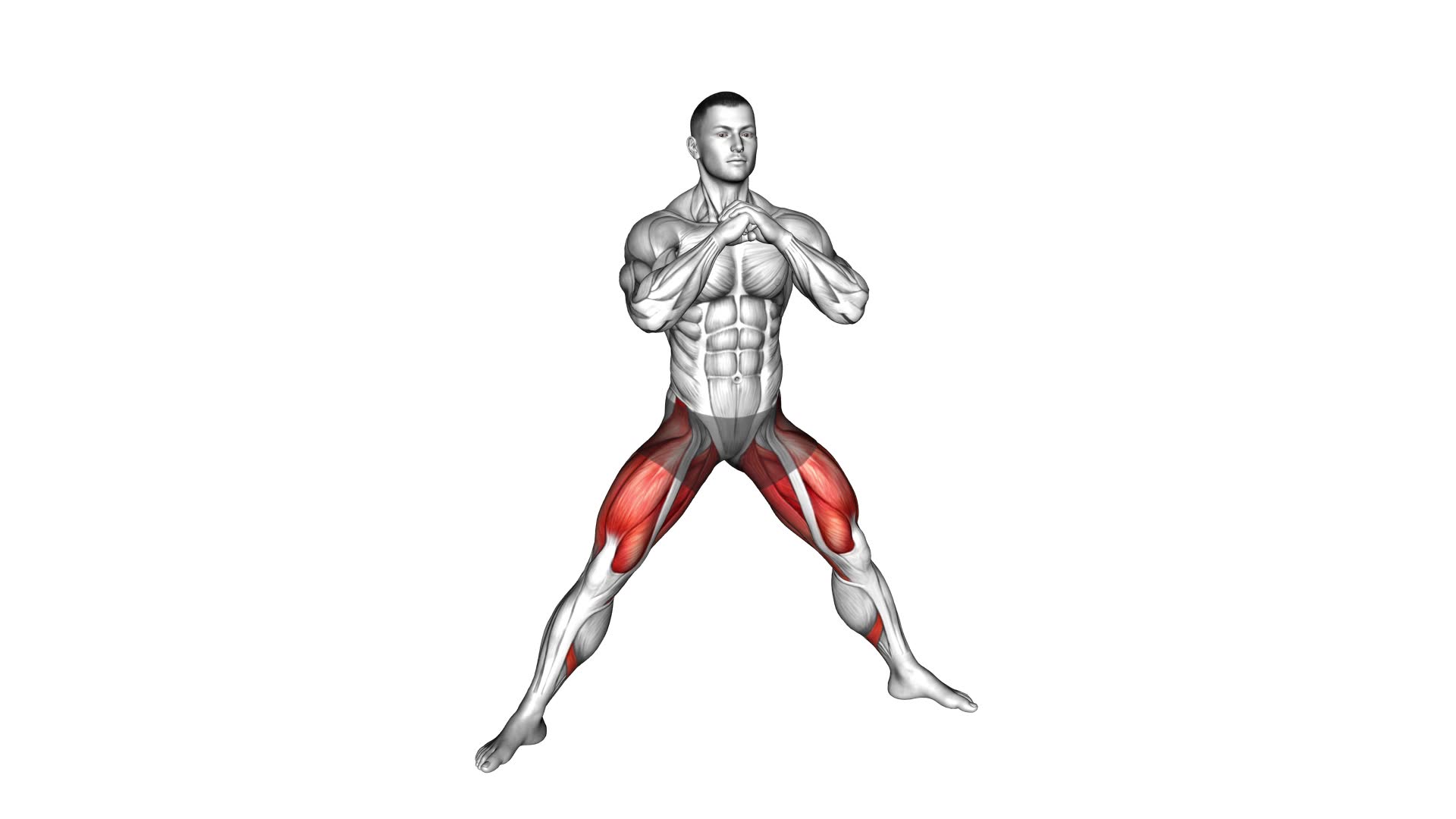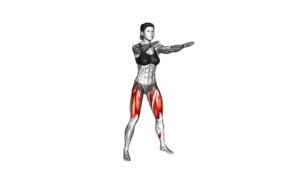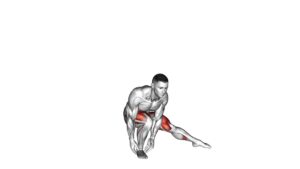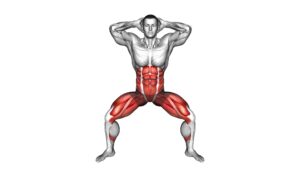Side Squat – Video Exercise Guide & Tips

In this video exercise guide, you'll learn all about the side squat and how it can benefit your fitness routine. With proper form and technique, you'll target key muscle groups while improving strength and stability.
Watch This Exercise Video
Whether you're a beginner or more advanced, we've got tips and modifications to help you get the most out of this effective exercise.
So grab your mat and let's get squatting!
Key Takeaways
- Position yourself beside a stable surface for balance and stability.
- Keep knees aligned with toes to avoid joint strain.
- Engage core muscles and push through heels when rising back up.
- Maintain a neutral spine to avoid lower back pressure.
Proper Form and Technique
To perform the side squat with proper form and technique, position yourself beside a stable surface such as a wall or chair. This will help you maintain balance and stability throughout the exercise.
One common mistake people make when performing the side squat is allowing their knees to collapse inward. It's important to keep your knees aligned with your toes to avoid unnecessary strain on the joints.
Another common misconception is that the side squat is primarily a leg exercise. While it does target the muscles in your legs, it also engages your core and glutes.
To maximize the benefits of the side squat, be sure to engage your core muscles and focus on pushing through your heels as you rise back up from the squat. Additionally, remember to maintain a neutral spine throughout the movement to avoid putting excessive pressure on your lower back.
Targeted Muscle Groups
The side squat targets the muscles in your legs, core, and glutes. This exercise is a great way to strengthen and tone multiple muscle groups simultaneously. Here are some key points to keep in mind:
- Side squat variations: You can perform the side squat in several ways to add variety to your workout routine. Try using dumbbells or a barbell to increase resistance and challenge your muscles even more. Another variation is the lateral lunge, where you step out to the side and lower your body into a squat position.
- Engage your core: To get the most out of the side squat, it's important to engage your core muscles throughout the movement. This will help stabilize your body and maintain proper form.
- Glute activation: The side squat specifically targets your glute muscles, helping to strengthen and tone your buttocks. Make sure to focus on squeezing your glutes as you return to the starting position.
Common mistakes to avoid:
- Leaning too far forward: It's important to maintain an upright posture during the side squat. Avoid leaning too far forward, as this can put unnecessary strain on your lower back.
- Allowing your knees to cave in: Keep your knees in line with your toes throughout the movement. Allowing them to cave in can increase the risk of injury.
By targeting multiple muscle groups, the side squat is an effective exercise for building strength and improving overall lower body stability.
Now, let's move on to the benefits of side squats.
Benefits of Side Squats
Now, let's explore the advantages of incorporating side squats into your fitness routine. Side squats offer numerous benefits, including injury prevention and calorie burning.
One of the key advantages of side squats is their ability to prevent injuries. By incorporating lateral movements into your squat routine, you engage muscles that are often neglected in traditional squats. This helps to improve overall stability and balance, reducing the risk of injury. Side squats also target the inner and outer thigh muscles, which can help to alleviate imbalances and improve overall lower body strength.
In addition to injury prevention, side squats are also effective for calorie burning. The lateral movement involved in side squats engages a wider range of muscles, which increases the intensity of the exercise. This leads to a higher calorie burn compared to traditional squats. Incorporating side squats into your routine can help you achieve your weight loss goals more efficiently.
Incorporating side squats into your fitness routine can provide you with a variety of benefits. From preventing injuries to burning calories, side squats offer a unique and effective way to enhance your overall fitness. So why not give side squats a try and experience the benefits for yourself?
Tips for Beginners
For beginners, it's important to focus on proper form and technique when performing side squats. This will help you avoid common mistakes and maximize the benefits of this exercise. Here are some tips to keep in mind as you get started:
- Maintain proper alignment: Stand with your feet shoulder-width apart and your toes pointing forward. Keep your chest lifted and your core engaged throughout the movement.
- Start with a proper warm-up: Before attempting side squats, make sure to warm up your muscles with dynamic stretches and light cardio exercises. This will increase blood flow to your muscles and reduce the risk of injury.
- Gradually increase intensity: As a beginner, it's important to start with lighter weights or no weights at all. Focus on mastering the movement and gradually increase the intensity as your strength and stability improve.
Advanced Variations and Modifications
To further challenge yourself and enhance your workout, consider incorporating advanced variations and modifications of the side squat exercise. These advanced modifications can help you target different muscles and increase the intensity of your workout.
One advanced variation is the weighted side squat, where you hold a dumbbell or kettlebell in one hand as you perform the exercise. This adds resistance and engages your muscles even more.
Another variation is the jumping side squat, where you explosively jump to the side as you lower into the squat position. This helps improve power and cardiovascular fitness.
When performing advanced variations of the side squat, it's important to be aware of common mistakes to avoid injury and get the most out of your workout.
One common mistake is letting your knees cave inwards as you lower into the squat. This can put excessive strain on your knees and increase the risk of injury. To prevent this, focus on pushing your knees outwards and maintaining proper alignment throughout the movement.
Another mistake is rushing through the exercise and sacrificing form for speed. Take your time and focus on maintaining proper technique to get the most benefit from each repetition.
Frequently Asked Questions
How Many Sets and Repetitions of Side Squats Should I Do for Optimal Results?
To get optimal results from side squats, you should aim for multiple sets and repetitions.
Incorporating side squats into your lower body workout routine offers several benefits, such as targeting the outer thighs and glutes.
If you're a beginner or have limited mobility, you can modify side squats by using a chair or wall for support.
Remember to maintain proper form and gradually increase the intensity to see the best results.
Can Side Squats Help Improve Balance and Stability?
Side squats can definitely help improve your balance and stability. By engaging the muscles in your legs, hips, and core, side squats strengthen your body's foundation, enhancing your overall stability.
This exercise also targets your glutes, inner thighs, and outer thighs, which can contribute to improved balance.
Additionally, side squats are beneficial for athletes as they help develop lower body strength and power, which are essential for various sports activities.
Are Side Squats Safe for Individuals With Knee or Hip Injuries?
Side squats can be a great exercise for strengthening your lower body, but if you have knee or hip injuries, modifications may be necessary. It's important to listen to your body and avoid any movements that cause pain or discomfort.
Instead of side squats, you might consider alternative exercises like lateral lunges or step-ups. These exercises can still help improve balance and stability without putting excessive strain on your knees or hips.
Can Side Squats Be Incorporated Into a Full Body Workout Routine?
Incorporating side squats into your full body workout routine can bring numerous benefits to your lower body strength. These exercises target your glutes, hips, and thighs, helping you build muscle and improve overall stability.
To modify side squats for different fitness levels, you can adjust the depth of the squat or use additional resistance, like dumbbells or resistance bands.
Adding side squats to your workout can be a challenging and effective way to work your lower body.
Do I Need Any Special Equipment to Perform Side Squats?
You don't need any special equipment for side squats. Side squats can be done using just your body weight. However, if you want to add some resistance, you can use dumbbells or a resistance band.
To modify side squats, you can start with a smaller range of motion or perform them with support like holding onto a chair or wall. Remember to keep proper form and engage your core throughout the exercise.
Conclusion
In conclusion, side squats are an effective exercise for targeting multiple muscle groups, including the glutes, quads, and inner thighs.
By maintaining proper form and technique, you can maximize the benefits of this exercise, such as improved lower body strength and stability.
Whether you're a beginner or advanced, there are variations and modifications available to challenge yourself and progress.
Incorporate side squats into your workout routine for a well-rounded lower body workout.

Author
Years ago, the spark of my life’s passion ignited in my mind the moment I stepped into the local gym for the first time. The inaugural bead of perspiration, the initial endeavor, the very first surge of endorphins, and a sense of pride that washed over me post-workout marked the beginning of my deep-seated interest in strength sports, fitness, and sports nutrition. This very curiosity blossomed rapidly into a profound fascination, propelling me to earn a Master’s degree in Physical Education from the Academy of Physical Education in Krakow, followed by a Sports Manager diploma from the Jagiellonian University. My journey of growth led me to gain more specialized qualifications, such as being a certified personal trainer with a focus on sports dietetics, a lifeguard, and an instructor for wellness and corrective gymnastics. Theoretical knowledge paired seamlessly with practical experience, reinforcing my belief that the transformation of individuals under my guidance was also a reflection of my personal growth. This belief holds true even today. Each day, I strive to push the boundaries and explore new realms. These realms gently elevate me to greater heights. The unique combination of passion for my field and the continuous quest for growth fuels my drive to break new ground.







